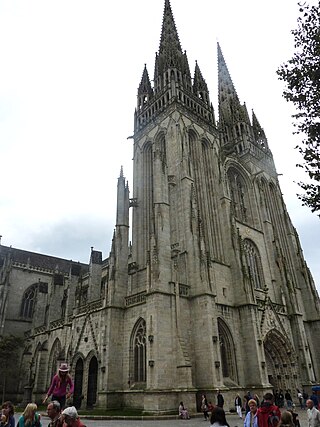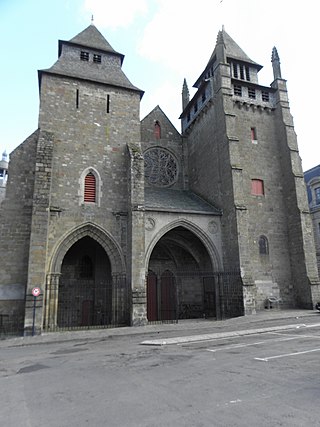
Saint Tudwal, also known as Tual, Tudgual, Tugdual, Tugual, Pabu, Papu, or Tugdualus (Latin), was a Breton monk, considered to be one of the seven founder saints of Brittany.

King Hoel, also known as Sir Howel, Saint Hywel and Hywel the Great, was a late 5th- and early 6th-century member of the ruling dynasty of Cornouaille. He may have ruled Cornouaille jointly after the restoration of his father, Budic II of Brittany, but he seems to have predeceased his father and left his young son, Tewdwr, as Budic's heir.

Tréguier is a port town in the French department of Côtes-d'Armor, Brittany, northwestern France. It is the capital town of the province of Trégor.
Tro Breizh is a Catholic pilgrimage that links the towns of the seven founding saints of Brittany. These seven saints were Celtic monks from Britain from around the 5th or 6th century who brought Christianity to Armorica and founded its first bishoprics.

The Bretons are an ethnic group native to Brittany, north-western France. They trace their heritage to groups of Brittonic speakers who emigrated from southwestern Great Britain, particularly Cornwall and Devon, mostly during the Anglo-Saxon settlement of Britain. They migrated in waves from the 3rd to 9th century into Armorica, which was subsequently named Brittany after them.

The Diocese of Quimper (–Cornouaille) and Léon is a Latin Church ecclesiastical territory or diocese of the Catholic Church in France. In 1853, the name was changed from the Diocese of Quimper (–Cornouaille) to the Diocese of Quimper (–Cornouaille) and Léon.

Saint-Brieuc Cathedral is a Roman Catholic church located in the town of Saint-Brieuc, Brittany, France, and dedicated to Saint Stephen.

Anatole le Braz, the "Bard of Brittany", was a Breton poet, folklore collector, and translator. He was highly regarded amongst both European and American scholars, and was known for his warmth and charm.

The former Breton and French diocese of Tréguier existed in Lower Brittany from about the sixth century, or later, to the French Revolution. Its see was at Tréguier, in the modern department of Côtes-d'Armor.

Tréguier Cathedral is a Roman Catholic church and former cathedral in Tréguier, Côtes-d'Armor, France. It is dedicated to Saint Tudwal. The church was formerly the seat of the Bishopric of Tréguier, abolished under the Concordat of 1801, when its territories were divided between the Diocese of Quimper and the Diocese of Saint-Brieuc, known since 1852 as Saint-Brieuc-Tréguier.

The Breton and French Catholic diocese of Dol existed from 848 to the French Revolution. It was suppressed by the Concordat of 1801. Its see was Dol Cathedral. Its scattered territory was shared mainly by the Diocese of Rennes and the Diocese of Saint-Brieuc.

The Diocese of Saint-Brieuc and Tréguier is a Latin Church diocese of the Catholic Church in France. The diocese comprises the department of Côtes d'Armor in the Region of Brittany. The diocese is currently suffragan to the Archdiocese of Rennes, Dol, and Saint-Malo. The current bishop is Denis Moutel, appointed in 2010.

Yves Hernot is the name of two sculptors, father and son, who ran the Ateliers Yves Hernot sculpture workshop in Lannion, Brittany, which specialised in creating Calvaries and tombs.

Poher is an ancient principality that emerged in the Early Middle Ages in Cornouaille in west-central Brittany. Its capital was the Gallo-Roman city of Vorgium, capital of the Osismii, which became Carhaix after the fall of the Roman Empire. Archaeological excavations scheduled since 1999 show that, even if the city lost its function as capital after the 4th century, it was nonetheless a stronghold and major strategic crossroads.

Saint Ruelin succeeded Saint Tudwal as Bishop of Tréguier. He died ca. 650. His fest is February 28.
Saint Pergat or Pergad or Pergobat or Bergat was a sixth-century Brenton bishop contemporary with Saint Ruelin. He is regarded as a saint in local Brenton calendars: His feast day is August 1st or August 3rd.
Kantik, or Breton Hymns are popular sacred songs in the Breton language sung at masses and pardons in Lower Brittany.














